Painting concrete
Hi, guys,
I've asked this question before as it's sort of come up in other threads, but not gotten a reply. So I'll ask it by itself!
What kind of paints can you use to paint concrete? How do you apply them so they're permanent? All advice and/or resources will be gratefully accepted!
Anna
Comments (43)
paws4pets
18 years agoLowes has Concrete Stain for concrete. You can get it in any color they have on the chart. They also have OOPS for $5 a gallon.
PawsDyas
Original Author18 years agoThanks, Paws--my Lowe's apparently doesn't have concrete stain. At least, I've never been able to find it. What's OOPS?
Related Professionals
Windham Landscape Architects & Landscape Designers · Grand Haven Landscape Architects & Landscape Designers · Ilchester Landscape Architects & Landscape Designers · Leawood Landscape Architects & Landscape Designers · Southfield Landscape Architects & Landscape Designers · East Patchogue Landscape Contractors · El Segundo Landscape Contractors · Flagstaff Landscape Contractors · Lake Saint Louis Landscape Contractors · Plymouth Landscape Contractors · San Antonio Landscape Contractors · Tavares Landscape Contractors · West Haverstraw Landscape Contractors · Reisterstown Landscape Contractors · Shafter Landscape ContractorsDyas
Original Author18 years agoYep, it's new. I should probably have been more specific. I'm going to cast some large "stones" for a walkway in concrete, then cover that with a 'tufa mixture. I want to (paint/stain/color/insert proper verb) the top layer so that it more closely resembles natural stone. I don't know what kinds of paints or colorants to use or how; I've looked through the archives but not found enough helpful information (at least, the dribs and drabs didn't give *me* enough info! :) ).
For instance, can I use concrete colorant as if it were paint? If I paint while the tufa or concrete is wet, will the pigments become part of the material and hence permanent? How do guys who paint surfaces on, say, stamped concrete make that work?
I seem to remember that someone on this forum, sometime, mentioned incorporating plain acrylic paints into the mixture. Am I nuts?
Thanks!
Anna
tango88
18 years agoSadly, there ain't no such critter as "permenent" paint for concrete. Not even close. A few years, depending on conditions. Most non-acid stains are relatively unstable and also subject to UV degradation (picture a UV ray telling a can of stain..."You are stupid and your mother dresses you funny!). There are some new gen, high-tech concrete paints that are much, much better than anything previously available, but they are mostly limited to designer hues such as Black, White & the ever popular International Safety Yellow. Very few people realize that nearly all of the fancy antique French faux bois garden furniture that is now a nicely patinated, pale gray cement color was painted at one time. The few pieces that still bear any traces of color do so only because people have continued to reapply it regularly for the hundred or so years that it's been around. Paint don't stick to concrete. Not for a period of time that's remotely like "permenent", anyhow. To me that means "for the life of the piece", but then you gotta' remember, I'm the lunatic who's actually shooting for multi-millenia durability.
That said, I think the color charts I put together for the group a while back are still accessable through the link below and might at least help get a handle on some of the options available.
Best to all...Here is a link that might be useful: Concrete Color Options
tufaenough
18 years agoAnna you aren't nuts, maybe just slightly warped like the rest of us tufa addicts.:)
I'm not a painter but if you are using peatmoss painting may not do what you want. It will either prevent the peat from rotting out or come off when the peat does rot out.
Staining is very cool but results can vary wildly.
The biggest problem with stain is finding small amounts, less than a gallon, in a nice variety of colors.
So folks here have had good results using wood stains. I haven't tried that yet but plan to in the future.I have had very mixed, mostly disapointing results trying to use concrete pigments as paint but I only have dry pigments. Liquid pigment may be better.
I use pigments integrated in my mix so don't have much advice to offer when it comes to applying color after the tufa has been applied.
Sorry I can't be more help.Dena6355
18 years agoHi Dyas,
At the risk of offending anyone or beginning a new debate about adding color, I feel I have to preface this posting and say this is what I have found through, reading, reviewing and sharing with others and personal experimentation.
I have used watered down latex paint, but I prefer water based acrylic, the kind you buy at Michaels or other craft stores. I water my acrylic colors down, others prefer a more definite thicker looking color. I like having a wide variety of colors to choose from. Sometimes I use a TileLab sealer after the color is dry sometimes not, the color does fade over the course of a few years in my area, Edmonds Washington zone8. I have used other sealers as well, tilelab is easily accessible and does not cost a bundle, and comes in reasonable sized containers.
I tend to use dry concrete colorant purchased at homedepot, a sakrete product(here in WA) when making most of the different mixes (intregal inside the actual mix, not applied is what I am referring to), just because I prefer some color other than sidewalk gray. Integrated into the mix you must not make the dry colorant any more than 1/10 of the amount of cement that you used in the recipe, a little can go a long way.
You can also use dry colorants and some oxides in different combinations to create in my opinion, fairly muted earthy tones, I would be happy to share a few combinations if that is what you are looking for. These can be used intregally (not sure if that is a word) or can be mixed with a little portland cement and water and painted onto the surface of a freshly wetted surface.
If you mix a dry concrete colorant with a little concrete fortifier/admix it can create a longer lasting color to most mixes that you might use. And if painted onto the surface will also last a little longer.
In regards to when to paint, I have found that I prefer to add color to the finished piece about 1 or more weeks after, when most of the initial cure has taken place. Painting prior to that may interfere with necessary hydration/chemical reaction that the piece has to go through to gain strength.
I have also tried wood stains and have found that they are a very nice compliment to natural rock formation and coloring.I hope this is helpful. I tried to give you information about options I have used.
DenaDyas
Original Author18 years agoTango, tufanuff and Dena!
Thank you very much. This gives me a lot more info than I had before, and thank you for the concrete color link--I may wear it out!
Dena, I'm intrigued that you say you use acrylic paints, and I'm just up the road from you in Bellingham (gorgeous day today, no?!?). What I'm thinking of is creating a rock-like texture on the surface (dips and slight rough spots) and then painting so the color variations mimic those of real rock, e.g., flagstone. Is that sort of what you're talking about? I may try using crinkled aluminum foil pressed on the top to see if that will give me the texture I want.
I was guessing that, if used when the piece is still damp or less cured, the paint pigments would be incorporated into the chemical mix, but I guess not. ?
I'm also thinking I'd better try a few small test pieces to see what works best!
(Yes, "integrally" is a word. :) )
I did discover concrete stains when snooping through Lowe's this afternoon, so I'll do a bit more research on that, too.
Two more little questions: What is OOPS?
What do you use for admix? I seem to recall someone said plain Elmer's glue at about 1/10 of the liquid volume worked well to add strength. This doesn't make sense to me--adding a water-based glue to add strength? Do you know why this works?
Anna
billie_ann
18 years agoAnna, OOPS are cans of paint that were mixed wrong or someone ordered the wrong color. They have them for sale at the paint counter in Home Depot and Lowes home improvement stores. Billie
Dena6355
18 years agoAnna,
You could texture your rock (if that is what you are making) with crinkle aluminum or wadded up plastic bag, or a plastic knife. I have not had much success with any durable acrylic being added while the mix is wet, as you are suggesting. My experience is that the paint will just sort of disappear before it initially dries.
I would create the texture 1st then apply watered down versions of your various colors until you get the color you want.
I found that on one of my rocks that I did, the walnut minwax stain was just what it needed to simulate a more rock like look.
It was pleasant weather here, relatives live in B-ham and say it was not as nice there.
If you have a way to post pics it is really nice to be able to see what you are working on.
denapaws4pets
18 years agoDitto Mary Ann. Sorry I was away at a MOLD AUCTION today. 1602 lots of MOLDS. Overload must.....calm.....down....take my pill....ARG
PawsDyas
Original Author18 years agoThanks, Billie Ann. Now I feel foolish--I should've thought of mix-boo-boos as oops! :-)
Dena, I'm intending to make flagstone-like rocks. I can't post pics as I haven't done anything yet! :) I have a fairly restrictive disability so I have to do a lot of planning beforehand to minimize the time and physical stress on the actual project. :)
The Minwax stain sounds like a strong possibility. Did you just wash it over the piece and let it settle in the low spots and wipe it off the highlights? It would also be easy to "touch up" as the stain weathered off, if necessary.
Definitely, I'll have to try some small pieces to see how best to approach this. Thanks, all of you, for your ideas and experience!
Anna
Dyas
Original Author18 years agoI did four small experiments on the kitchen table yesterday, using different proportions of materials, and ... well, suffice it to say I'll try again. :)
Obviously, if you want a rock-like texture on the surface and you're going to press it in, you have to be there at exactly the right moment. Too soon, and you get no pattern; too late (as I was, since I had to take some stuff to my mom yesterday) and it's too hard to accept impressions.
The crinkled aluminum foil didn't do too badly--I just crinkled it, pressed it into the wet surface and left it there--but aluminum is chemically very reactive and there are some white spots on two of the experiments that suggest there's now some aluminum oxide or something on the tufa. :)
I asked the guy at Lowe's about using concrete sealer over, say, a paint or wood stain. He said that it wouldn't penetrate enough to dry; it would just stay sticky. That would be a problem. I wonder if it would seal properly over concrete stain?
Back to the drawing board!
Anna
tufaenough
18 years agoAnna, I'm confused.
I can't figure out exactly what you are trying to accomplish.
Can you find a picture on the web of something close and point us at it.:)tufaenough
18 years agoThe other questions I have is how are you casting these. Face up or face down?
Are you top coating preformed concrete slabs with a tufa recipe?
What recipe are you using?
If you are just topcoating these is there any reason why you can't use integrated concrete pigments instead of paint?
Browns, blacks and yellows are very cheap pigments to use.Dyas
Original Author18 years agoHi, tufaenough,
Sorry. I tend to get ahead of myself mentally (my fingers can't keep up). Unfair!
The plan is to cast concrete stones in place, face up, on my walkway. I expect to use flashing, held together by duct tape and stuck into sand (as a "bedding"), as molds to mimic flagstone shapes.
I want a flagstone-like texture, too, which I expect to be complicated to get (but maybe not--this will be my first project, so I'm probably thinking it's hard 'cause I don't know how to do it). I was thinking I'd need to put a 'tufa coating on top to achieve this, but I could be wrong.
Then, I want color variations in the surface to look like natural flagstone colors--darks and lights and midtones with the higher and lower elevations of "stone." The only way I've been able to think of getting this is to paint it in some way. If there's a way to integrate it with the concrete, that's fantastic. I've just not been able to find anything that specifically references it.
I asked about using concrete pigments, but the replies I got suggested that they were best for an even, all-over color rather than highlights/lowlights. Can you use them like a paint (the liquid ones, anyway, which are all I have available)? If so, how would you do that?
I hope this makes sense and I'd be delighted with any experience/advice y'all can offer. Sorry again for being unclear!
Anna
tufaenough
18 years agoIt's pouring out rain but I ran out and snapped this picture as a closeup (12 inches away) of pigment colored tufa sandstone in my walkway. the wet hides some of the detail.
{{gwi:69626}}
Dyas
Original Author18 years agotufaenough! Bless you, my child! This makes much more sense to me than the bits and pieces I was collecting from reading a bit here and there. And thank you buckets for the picture, buckets of rain notwithstanding.
Is the coarse (filter) sand for strength or for texture?
Anna
tufaenough
18 years agoThe course filter sand is for texture and the nice beige color goes well with many sandstones.
You don't need it but try to avoid fine playground sand. Buy as course a sand as you can find.
Masons sharp sand is pretty good.
This really helps avoid that flat concrete look.Dyas
Original Author18 years agoWill do! I assume, since you suggested it, that applying stone sealers over concrete stain will work (as the Lowe's dude said the sealers wouldn't over wood stain or paint)? I'd think they'd be manufactured to be compatible with each other.
But then, I think a lot of things! :D
Thanks again!
tufaenough
18 years agoHi Anna
Just make sure the sealer you use is formulated to play nice with your concrete stains.
I pretty sure the company that manufactures the stains will recommend a compatable sealer, probably their own.
Just remember if you want a flat sandstone look don't use a glossy sealer.flowersmakemesmile
18 years agoWell I'm so glad I hit this thread as I have had a blast casting false rhubarb leaves and creating stepping stones of which I made both from a mixture of portland and sand ratio of 1:3. I have pressed ferns into the stepping stones and mounted the leaves onto copper pipe so they are much like a bird bath. Now I'm at the painting stage. I am wondering; after reading this, how my watered down acrylics from walmart & joann fabrics will work. I am looking for a washed effect. Then an aging process using stain like I do with my wood crafts. Then I had planned to use concrete sealer on top. Will this not work; acrylics, stain and concrete sealer?
Dena6355
18 years agoFlowersmakemesmile,
I use watered down acrylic paints and when I seal either use TileLab sealant (in the tile isle and there are different varieties of this) or a concrete sealer. I have had good luck with both.
I don't always use sealer though.
Denaflowersmakemesmile
18 years agoThanks for your quick reply, Dena. I love what you have done and that helped to inspire me. Doesn't the paint just peel off? I suppose it soaks in due to the watering down of it. I am so addicted to doing this stuff, now. I am in a local garden show and am hoping to sell some of it. If not, christmas presents for my sister-in-laws!!
Dena6355
18 years agoIn my experience, those pieces that I have used an admix/fortifier/bonding agent in the mix seem to have less ability to 'soak' up the painted on surface. When I have added a little fortifier to the diluted paint it seems to hold better.
I use fairly diluted colors sometimes, other times may be 1 part paint to 1/4 water, all depends on the look I want. I do not have things peeling here.
Great success for you venture at the garden show.
DenaDyas
Original Author18 years agoThanks for the extra info, Dena and flowersmakemesmile (that's a lot of typing! :) ). Dena, what kind of admix/fortifier do you use? Is it true that plain old Elmer's glue will work as a fortifier?
Anna
whoda_thunk_it
18 years agoDoes anyone ever add acrylic paint to your water when mixing the tufa? Or apply diluted paint to the piece to hydrate it as it cures?
I was thinking of making a piece then applying a thinlayer of portland slurry and painting as in fresco work.
Any experience anyone?Fleur
18 years agoI wonder if anyone has experience using the Apple Barrel acrylic craft paints for painting on or incorporating into the cement before casting. I'd like to try that, if it would work, as I have a fair supply of those little jars. The directions indicate that it can be used on porous surfaces. Anyone have any idea?
buckyforce
18 years agoI think I have said it before, and I'll say it again...\
When I first started getting hopelessly addicted, I approached a guy that was obviously a house painter in the hardware store and asked him what the best paint for concrete was. Sometimes the most obvious things escape us. His answer? (D-U-H I thought to myself after I heard it...) Exterior latex house paint. Now think about it, most of our houses are concrete/stucco and they are painted and the paint sticks for years! It may fade or get chalky after 10 or so years but then again our houses don't get much foot traffic on the walls either! I have been told to use a good quality primer followed by a good quality exterior latex paint.
I haven't used the primer as yet, but DO use the paint recommended. I have painted, cast leaves that have been out in all the weather south Florida has too offer, mostly many feet of rain, and have seen NO appreciable wear. I DO add bonding agent and water to thin the paint, as I apply it with an airbrush. As an artist friend of mine told me early on, "that bonding agent will make paint stick to anything!" In applications such as pavers where a lot of wear is expected, I would experiment with the primer followed by a top coat of exterior latex, and/or concrete colorant to pick up the slack if the paint wears off over time.
That's my story and I'm stickin' to it!
Dyas
Original Author18 years ago(smacking self in forehead)
DUH is right. That should have been completely, totally, utterly obvious... but it wasn't. Of such is genius made. :)
Anna
User
18 years agoI experimented with little squeeze bottles of black craft paints to color a cement mower strip I free-handed. I diluted different amounts to each small batch to get varying tones of gray. I did this 2 years ago and I don't notice any fading.
{{gwi:69627}}Dena6355
18 years agoDyas,
You asked about fortifier. You can find it in the cement products isle. I have used quickrete and sakrete products, and a couple others.
Quickrete has 'bonding agent' and then a 'fortifier', sakrete combines the two and I prefer this product when doing leaves, I add a small amount to the mix sometimes.
The sakrete product I can add with my acrylic paints and still thin to what ever density I want.
Dian,
Lovely mowstrip!, It has been on my project list for quite some time, thank you for sharing the photo.
Denarickharmer
18 years agoIf you have a Benjamin Moore paint store nearby,they have small plastic containers of every one of their colours.It'll cover 7 square feet,so,if you're diluting...
we're also advised that any colour that they have,they can do it in a stain as well!
A little painting music,please!!
CheersDyas
Original Author18 years agoDian, thanks for the shot of the mower strip--looks lovely!
Dena, thank you for more info on the fortifier. Hopefully, I'll be able to get out of the house today (I telecommute, so me 'n' the boids is about it) and do some hunting at concrete outfits.
Rickharmer, I've seen these little packets at our trusty local Hardware Sales--as much like an old-style hardware store as you'll ever find, with bins of nuts, bolts, nails, washers, you name it, and stuff packed from floor to ceiling. Should be perfect!
Anna
Belgianpup
18 years agoHas anyone ever tried using those acrylic paints that are advertised to be used specifically outdoors?
Dena, have you ever tried diluting the acrylics WITH the fortifier?
Sue
tufaenough
18 years agoRead the instructions before mixing acrylics and fortifier.
It's generally not recommended unless the products are designed to work together.
Besides you don't need both.:)Fleur
18 years agoFWIW - My local hardware store will sell me small quantities of the colorant they use to mix custom color paints. I can (when I'm ready to paint concrete cast leaves) pick out paint chips and they'll sell me the colorant. Haven't done it yet but will give it a try. I'll probably have to take along small containers in which to put the stuff and stir it up myself.
bcmouli
18 years agoHas anyone ever tried spray painting on concrete or tufa?
The paints are advertised that they can be used on masonry.
Can one spray paint (special types like rock pattern)and use a concrete sealer on top?paws4pets
18 years agoIm have used Krylon outdoor paint for some stones I make and it works good. Gets in the crackes and holes better than a brush. I don't have any long term results from being outside yet.
Pawskris1413
18 years agoI made a lantern and wanted it to match the outdoor patio which is stained and faux finished. I ended up using some left over gel stain. I only did the tops and sides so it would still get water on/in it and cure harder over time. So far so good! The water beads up on the top when it rains so the top is water proof while the rest takes in water. The gel stain was easy to work with and the color is bright. I will let you know if I see any changes in it.
dgrantin
14 years agoI am going to paint new concrete. The first area is between the wood siding and the cement apron in the front of my garage. I am also going to be painting the inside foundation which is about 20" in height. Do I need to etch with the acid before I do this. The concrete is all pretty clean. The etching just sounds too dangerous because of the chemicals and to have to rinse so thourouly does not appeal to me. Can I just paint or would I have to prime then paint and can I avoid this etching process. Thanks for anyone's input on this. Dana
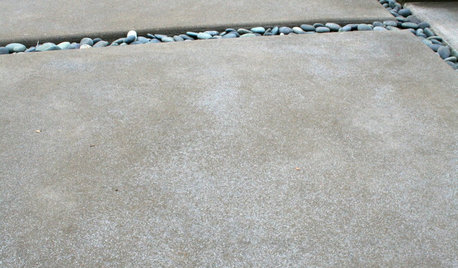


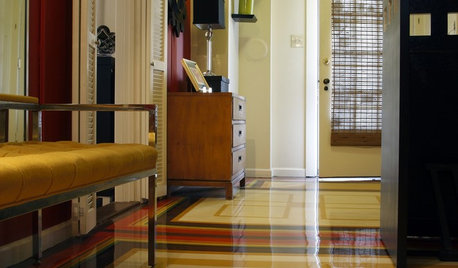
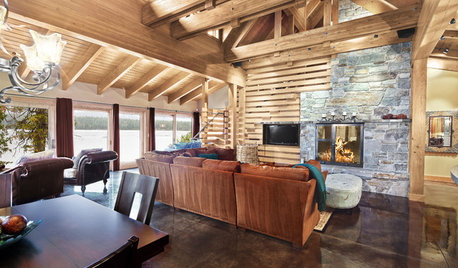

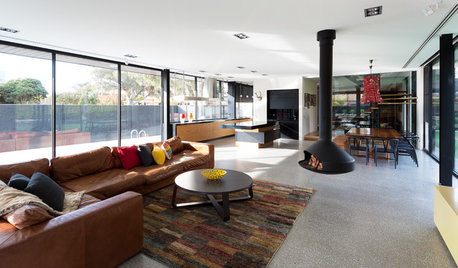
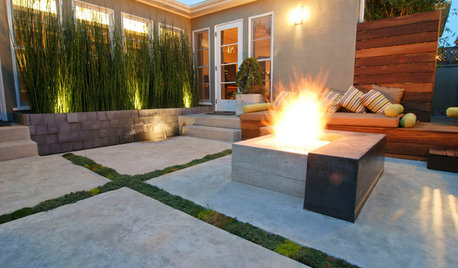
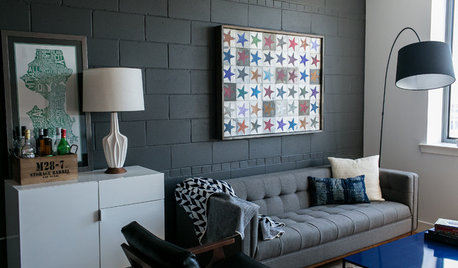
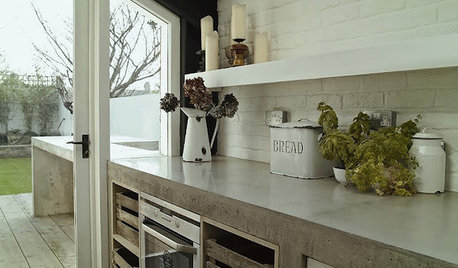






tufaenough